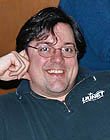|
|
This topic comprises 2 pages: 1 2
|
|
Author
|
Topic: Surround speaker cable run length - same?
|
|
|
|
|
|
|
|
|
Randy Stankey
Film God

Posts: 6539
From: Erie, Pennsylvania
Registered: Jun 99
|
 posted 11-03-2009 11:29 AM
posted 11-03-2009 11:29 AM




If you had enough wire to go all the way around the world at the equator you might calculate a delay of 0.13 seconds.
(24,900 mi. ÷ 186,282 mi./sec. = 0.133668309337 sec.)
However, there is something else. Even if you have a wire that goes 10 times around the world, there will be almost no delay.
As you push electrons into the wire, electrons will come out of the wire at the other end almost instantly. Imagine a wire as if it was a very long tube. Imagine that the electrons are billiard balls.
There are ALREADY electrons inside the wire. They are just standing still. When you push a new electron into the pipe, one of the electrons already in the pipe gets pushed out the other end. It takes almost no time for this to happen. There might be a delay but it would be so small that it would be virtually unmeasurable unless the wire was very, very long.
It would have to be a wire long enough to reach the moon for there to be a noticeable delay.
The only thing you would have to worry about is impedance in a long run of wire but, with a good amplifier which is hooked up correctly, this will not be a problem.
| IP: Logged
|
|
|
|
|
|
|
|
|
|
|
|
|
|
|
|
|
|
|
|
Steve Guttag
We forgot the crackers Gromit!!!

Posts: 12814
From: Annapolis, MD
Registered: Dec 1999
|
 posted 11-04-2009 08:55 PM
posted 11-04-2009 08:55 PM




The propagation delay in copper is quite measurable and when dealing with video, one can easily get "skew" if R, G and B color cables are not of the same length...but even at those higher frequencies, it actually has to be off by feet to see the skew (looks like things are not converged...because they aren't!).
For audio frequencies/times there isn't enough wire in the theatre to cause a audible cue to the problem. However, the impedance (which is the cumulative effects of resistive and reactive components) is something that can indeed add up. The intensity of the speakers could be different, due to cable length, if they are drastically different, even if all paralleled since the furthest speaker will have a higher impedance cable than the shortest distance speaker.
I have never personally balanced the length of speaker cables in a theatre though I have certainly balanced video cables off of a DA and ensured that RGB cables are equal length (or use skew-free UTP cable) for video.
To add to Mark's post about the QSC amps...many don't realize it and QSC doesn't advertise it very well but the DCA1222 will run into 1.6-Ohms just fine...in fact, it was designed to do that...so go ahead and parallel 5 8-ohm speakers on a DCA1222. None of the other DCA amps can do this however, just the DCA1222.
When doing a series parallel...have more of the speakers in parallel too. So if you have say, 6 surrounds in a group...parallel three, then parallel the other three and then series the two groups. In this manner, if one speaker fails, it has a much smaller effect on the rest of the group. Also you are only presenting a 2.67-Ohm series impedance to each sub-group. If you do it the other ways, you will increase the series impedance to any sub-group and also raise the severity of any single failure.
Steve
| IP: Logged
|
|
|
|
All times are Central (GMT -6:00)
|
This topic comprises 2 pages: 1 2
|
Powered by Infopop Corporation
UBB.classicTM
6.3.1.2
The Film-Tech Forums are designed for various members related to the cinema industry to express their opinions, viewpoints and testimonials on various products, services and events based upon speculation, personal knowledge and factual information through use, therefore all views represented here allow no liability upon the publishers of this web site and the owners of said views assume no liability for any ill will resulting from these postings. The posts made here are for educational as well as entertainment purposes and as such anyone viewing this portion of the website must accept these views as statements of the author of that opinion
and agrees to release the authors from any and all liability.
|

 Home
Home
 Products
Products
 Store
Store
 Forum
Forum
 Warehouse
Warehouse
 Contact Us
Contact Us




 Printer-friendly view of this topic
Printer-friendly view of this topic











![[Razz]](tongue.gif)


![[beer]](graemlins/beer.gif) Louis
Louis





